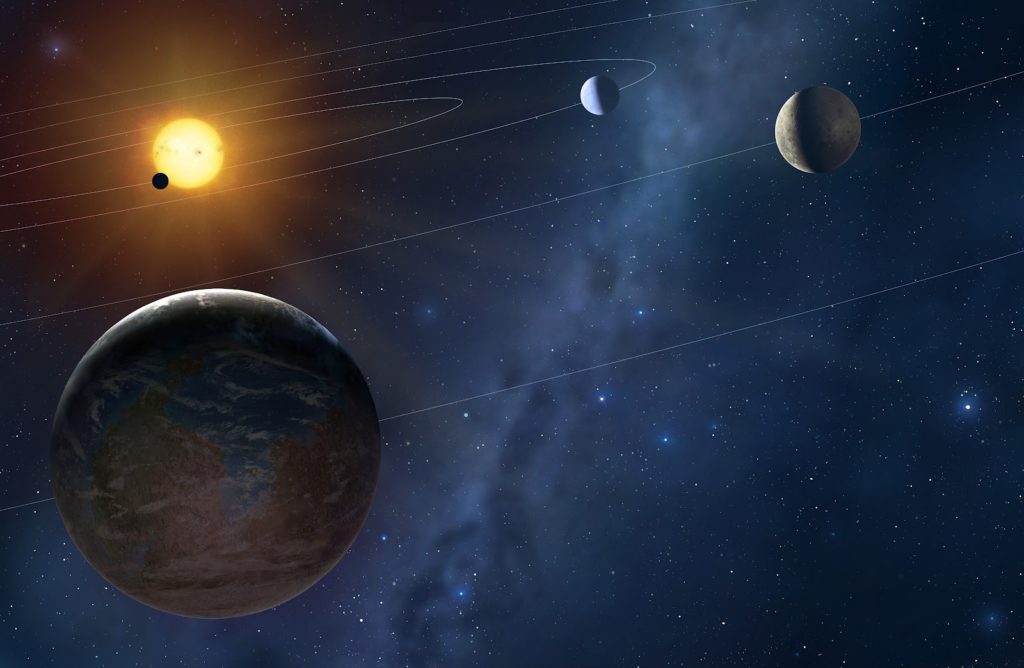Detecting life on a planet beyond Earth would be one of the coolest things ever! In our paper, we talk about detecting signs of life on other planets that breathe out oxygen. While this strategy would only detect Earth-like life, it is a good starting point. To accomplish this, we want ask two questions. Does this atmosphere contain gases that only life could produce, such as oxygen or carbon dioxide? How much total “stuff” is in the atmosphere to begin with?
In our own solar system, the atmospheres of Mars and Venus have about the same fraction of their atmosphere that is carbon dioxide, but the total pressure of Mars is 35 millibars, or about 1000 times less than the pressure on Earth. This is very small compared to Venus that is about 90 bars, or about 90 times more than on Earth. This pressure difference causes Venus to be much hotter than Mars. Mars, therefore, is much colder than Earth due in part to it’s low pressure. It is critical to be able to measure the pressure of an atmosphere in order to determine the temperature of the planet and whether or not life could exist there. The techniques described in our paper could be used to measure both signs of life and the atmospheric pressure of some planets around other stars.
A classic “biosignature,” or sign of life, is the presence of three gasses in a planet’s atmosphere — oxygen, ozone, and methane. Oxygen and ozone are very reactive, meaning they readily engage in chemical reactions. It is only possible to have two such reactive gasses if there is a large source of both from the surface of the planet. There are no other mechanisms we know of that cause oxygen, O2 and methane together except for life. Abiotic, or non-life systems, like volcanoes or geysers, cannot produce such large quantities of oxygen and methane at the same time.
This is not a fully bulletproof argument, and I’ve recently been involved in an extensive effort to explore “false positives” for the oxygen/methane biosignature (stay tuned for details!), but rest assured it works very well for Earth-like atmospheres around Earth-like stars.
Regardless, detecting oxygen or ozone in large quantities by themselves would be a very interesting measurement to make on another planet, but it is quite challenging. We discuss a novel method of detecting oxygen by means of its dimer molecule. What’s a dimer? Oxygen atoms travel in pairs (which is why it is abbreviated as O2) called monomers, but when you have two sets of pairs, you have a dimer.

This is what a molecule of oxygen looks like in it’s monomer form.
When there are lots of oxygen molecules in an atmosphere, some of the molecules will occasionally stick together, forming an O2-O2 “dimer molecule” for a brief moment. Usually another molecule will collide with it and will break it back apart into the much more common O2 “monomer molecule.” We describe how to detect this O2-O2 dimer molecule over long interstellar distances using the James Webb Space telescope which is scheduled for launch in 2018. We should be able to determine the presence of oxygen using this method in the near future.

A scale replica of the James Webb Telescope, scheduled for launch in 2018
It turns out the same technique to measure O2 dimer molecules may also tell us about the total atmospheric pressure on the planet. This is exciting because as discussed previously, the atmospheric pressure can make a big difference for what the planet is like to live on. This is possible because both O2-O2 formation and destruction depends on the amount of “stuff” in the atmosphere. What kind of stuff, you ask? Mostly debris, dust, and any other chemical that could potentially bump into the oxygen dimers.
O2-O2 formation is dependent on how often the O2 molecules collide with each other. The amount of they are colliding tells us the percentage of the atmosphere that is O2. Simply imagine a crowded party — people will bump into each other more when there are more people in the party. Similarly, the number of gas molecules in a certain amount of space determines the pressure of the gas.
Oxygen dimers are destroyed when they run into any other molecule in the atmosphere. By measuring both the O2 and O2-O2 of the planetary atmosphere, we can roughly predict the total pressure of the atmosphere by seeing how much of the dimer oxygen was destroyed. There are limits to this method as it only works for planets in close orbits around very small stars with lots of O2, it is still very cool as it is feasible with existing technology, and can help us detect life on other planets!


